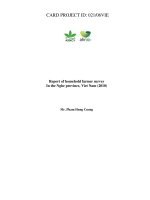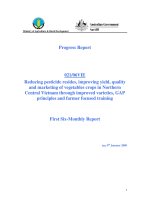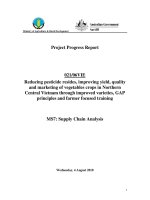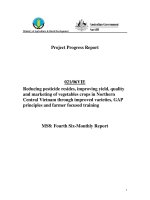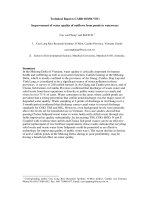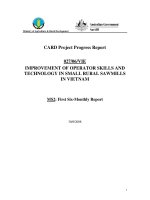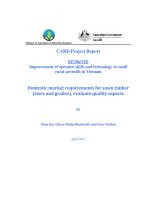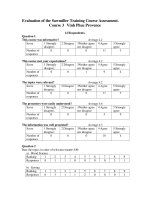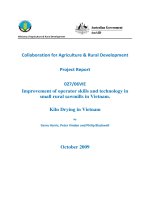Báo cáo khoa học nông nghiệp " Improvement of operator skills and technology in small rural sawmills in Vietnam Domestic market requirements for sawn timber (sizes and grades), evaluate quality aspects " pptx
Bạn đang xem bản rút gọn của tài liệu. Xem và tải ngay bản đầy đủ của tài liệu tại đây (159.25 KB, 12 trang )
Ministry of Agriculture & Rural Development
CARD Project Report
027/06/VIE
Improvement of operator skills and technology in small
rural sawmills in Vietnam
Domesticmarketrequirementsforsawntimber
(sizesandgrades),evaluatequalityaspects
By
PhanDucChien,PhilipBlackwellandPeterVinden
April 2010
ProjectReport 027/06VIE
ImprovementofoperatorskillsandtechnologyinsmallruralsawmillsinVietnam.
Domesticmarketrequirementsforsawntimber Page2of12
(sizesandgrades),evaluatequalityaspects
Table of Content
1. Domestic wood market of Vietnam 3
2. Forest products industry and timber processing technology 4
3. Timber supply of Vietnam 5
3.1. Forest land of Vietnam 5
3.2. Domestic timber production 6
3.3. Sawn wood production and trade 7
3.4. Furniture production and trade 8
3.5. Wood based panel production and trade 8
3.6. Pulp and paper production and trade 9
3.7. Wood chip production and trade 10
3.8. Vietnam’s timber use and imports 10
3.9. Timber imports 11
ProjectReport 027/06VIE
ImprovementofoperatorskillsandtechnologyinsmallruralsawmillsinVietnam.
Domesticmarketrequirementsforsawntimber Page3of12
(sizesandgrades),evaluatequalityaspects
1. Domestic wood market of Vietnam
Domestic wood consumption in 1993 was estimated as follows: Sawmills used more
than 2 million m3 round wood; MDF producers used 70,000 m3, and particle board
manufacturers used 140,000 m3. National demand for wood was mainly satisfied
through natural forest exploitation and imported wood while plantation forests
(consist of rubber) played only a limited role due to the small amount of saw logs
produced by plantations.
The wood processing industry in Vietnam plays an important role in increasing the
value of products produced by the forestry sectors. Forestry products in Vietnam are
diverse and include many classes, from products having undergone minimal
processing such as sawn timber, flooring, plywood and chipboard to more processed
products for direct consumption such as tea chests, beds, wardrobes, sofas and
other furniture.
Table 1 shows wood industry capacity and production in Vietnam for the period 2001-
2005. Sawn timber remains the most important product by volume although the
production of woodchips is also considerable. Since 2005 there has been significant
growth in the production of wood furniture in Vietnam and this is likely to increase as
long as supply remains. For most products, however, installed capacity exceeds
production due to a shortfall in supply resulting from diminishing timber extraction in
Vietnam over the past decade.
Table 1: Average annual wood industry capacity and production in Vietnam 2001-2005
Product Capacity Production
Sawn timber 4,000,000 m
3
2,165,000 m
3
MDF 144,000 m
3
84,000 m
3
Plywood 150,000 m
3
60,000 m
3
Paper 970,000 m
3
30,000 m
3
Pulp 682,000 t 642,000 t
Wood furniture - 1,042,000 m
3
products
Wood chips - 1,800,000 bone dry tonnes
Mine pole, scaffold - 80,000 m
3
(Source: Vietnam association of timber and forest products, 2005)
Table 2 shows that national consumption in 2005 exceeded that in 2003 for almost all
wood products and that the value of exports increased at a much higher rate
reflecting the focus on value addition and increase in the export of furniture.
ProjectReport 027/06VIE
ImprovementofoperatorskillsandtechnologyinsmallruralsawmillsinVietnam.
Domesticmarketrequirementsforsawntimber Page4of12
(sizesandgrades),evaluatequalityaspects
Table 2: Volume of wood consumption in 2003 and 2005
Consumption 2003 2005
Consumption of domestic wood and export (‘000m
3
) 7,420 10,063
Large size timber in industrial sector and civil construction 4,561 5,373
Small timber for panels and wood chips for export 1,649 2,032
Small timber for producing wood pulp, 1,150 2,568
Mine poles 60 90
Value of exported forestry products (million US$)
721 1,700
Wood products 567 1,500
NTFPs 154 200
Fuel-wood consumption (million m
3
) 25 25
2. Forest products industry and timber processing technology
Currently there are 1,200 timber processing enterprises in Vietnam of which 24% are
state owned, 10.4% are joint ventures and 65.6% are non-state owned enterprises.
The technology used in Vietnam’s wood processing industry has progressed in
recent years although there is still a big gap in comparison with the most advanced
countries. In the future, if there is no renewal of equipment or update in technology, it
will be hard for wood products from Vietnam to compete in international markets.
The total capacity of the saw milling industry is estimated to be 3 to 4 million m
3
per
year. In 2003, MDF production capacity was 54,000 m
3
although recently, a factory
with 60,000 m
3
capacity was established. Particle board production capacity was
estimated at 80,000m
3
in 2003 and in 2001, 6 plywood factories were in operation.
Most of the country’s sawmills are small and produce only 1000 to 2000 m
3
/per year.
In general, investment in capital is low and the mills can only meet limited demand for
products that are of insufficient quality for higher paying markets. The mills do,
however, employ many labourers and take advantage of people’s available time
outside of harvesting periods.
Timber processing technology includes many different areas covering the full
spectrum of forest products production from harvesting to finishing of highly
processed products. The production of sawn wood in the past was commonly done
using crosscut saws and band saws. Both types of saw are, however, slow, have low
capacity and are inefficient in terms of wood loss. During recent years, vertical
electrically controlled hole saws have been increasingly used and many countries
have applied digital technology to design a cutting map before sawing. This
technology has, however, not been applied in Vietnam.
With respect to timber drying, there are four methods that are generally available (1)
Freeze drying, (2) heat drying, (3) steam drying and (4) ‘air drying. Steam drying is
the most commonly used method in Vietnam.
In general, investments in wood and forest products processing equipment have
been insufficient in Vietnam and innovation has fallen behind, especially in the
Northern region. Proportions of consumption accounted for by different processes
and products are as follows:
ProjectReport 027/06VIE
ImprovementofoperatorskillsandtechnologyinsmallruralsawmillsinVietnam.
Domesticmarketrequirementsforsawntimber Page5of12
(sizesandgrades),evaluatequalityaspects
• Saw milling and wood preliminary treatments account for approximately 40%
of the total processing capacity, including domestically manufactured band saws and
disk saws as well as one-sided planers, moulding machines and drills the majority of
which are imported from Taiwan, China, Czech and Japan.
• Equipment for refining and finishing timber to produce furniture account for
about 50% of the total processing capacity and includes three and four side-planers,
one or two-axis milling machines, tenon milling machines, multi-bullet drillers,
polishing machines, lathes and drying-rooms. In recent years, most establishments
have imported comprehensive assemblies and high-tech equipment from Japan,
France, Taiwan and South Korea.
• Lines for producing panels accounts for 10% of the total processing capacity.
Some lines are synchronous but many use dated technology and only lines installed
since 1995 utilise modern technology and equipment.
• Total processing capacity is around 4 million m
3
round timber per year, but
only 2 million m
3
per year are actually processed.
Increasing investments have been made in the pulp and paper industry. However, in
general, Vietnam’s paper manufacturing facilities are small scale and use dated
technology. These factories also cause a lot of pollution, especially those producing
non-wood pulp, and paper produced in Vietnam is of low quality and cannot compete
with imported paper either for quality or price. Recently, new investments have
enabled purchase of new technology but product quality hasn’t met the export
requirements and other factors also need to be dealt with.
Currently there are nearly 300 paper production facilities in Vietnam but the total
capacity is under 20,000 tonnes. The scale of a company necessary to be
competitive is about 10 times higher than the current average capacity. For example,
new facilities in Thailand, China and Indonesia have capacities of over 500,000
tonnes.
In 2003, Vietnam produced nearly 640,000 tonnes of pulp and consumed
approximately 2.6 million m
3
wood. Major raw materials for these companies are
wood-pulp, waste paper and bamboo and in 2003 the estimated proportions
consumed were: 80% wood pulp and 20% non-wooden pulp and waste paper.
Demand for wood pulp imports has been gradually increased due to increased
requirements for higher quality inputs.
3. Timber supply of Vietnam
3.1. Forest land of Vietnam
In 2005 the Government of Vietnam categorized 19.02 million ha as Forest Land.
This area is broken down into three land use classifications: Production Forest
covering 7.1 million ha, Protection Forest covering 9.47 million ha, and Special-Use
Forest covering 2.32 million ha. The Production Forest area is dedicated to supplying
timber from natural forests and from plantations.
In 2006, Vietnam’s government has reclassified the national forest land. There are
16.24 million ha that have been categorized as forest land. Moreover, area for
production forest has received a priority in reclassification. As stated in Vietnam
Forestry Development Strategy 2006-2020, 8.4 million ha or 51.72% of the national
forest land have been defined as production forest. Meanwhile, protection forest has
ProjectReport 027/06VIE
ImprovementofoperatorskillsandtechnologyinsmallruralsawmillsinVietnam.
Domesticmarketrequirementsforsawntimber Page6of12
(sizesandgrades),evaluatequalityaspects
received less attention than previous time. The area of protection forest has reduced
from 9.47 million ha to 5.68 million ha.
The largest areas of Production Forest are located in the Northeast, North Central,
and Central Highland areas, which together comprise around 75 percent of the total
Production Forest area. Of the total Production Forest area 3.1 million ha were
classified as natural forest and 1.4 million ha as plantation forest, leaving 2.6 million
ha as unused land, which presumably implies lack of forest cover.
The Government’s goal is to increase the area of forest cover, from 12.6 million ha in
2005 to 15.6 million ha by 2020, largely by increasing the planted forest area within
Production Forests from 4.48 million ha to 7.78 million ha. To achieve this, the
Government has implemented a number of policies to encourage rural farmers to
plant trees. These include policies on forest land allocation, benefit sharing,
restructuring of state forest enterprises, forest land classification, establishment of
wood processing units, and removal of barriers that prevent planters from selling their
timber.
3.2. Domestic timber production
To address a long-term deforestation trend, the Government implemented a series of
measures to drastically decrease logging. In 1992 the government imposed an export
ban on logs and sawn wood, followed by a partial logging ban in 1997, and by a
severe curtailing of the annual allowable cut (AAC) to only 300,000 m3 per year in
1999 (Barney 2005). By 2003, legal harvesting of natural forests had totally ceased in
northern Vietnam, in the Red River delta, and in the south-eastern Mekong Delta
(Brown and Durst 2003). However, analysts point out that actual harvests greatly
exceed the AAC. For example, Waggener (2001) estimates total removals of large
diameter (>30cm) wood at 1.35 million m3. This is includes timber from illegal
harvests attributable to commercial harvesting operations, from small-scale
operators, and from land clearing for cash cropping (Barney 2005).
In tandem with reducing harvests of natural forests, Vietnam embarked on a program
to aggressively increase the supply of wood from timber plantations. The Five Million
Hectare Reforestation Program (5MHRP) was launched in 1998 and includes
reforestation of degraded land, improved forest law enforcement, and natural
regeneration of logged over areas. New planting is constrained by a lack of suitable
land, and the 5MHRP has had to focus on the northern region where there are few
industrial scale wood processing factories (PTMFPV 2008). According to MARD, by
2020, plantations will be able to supply 20 million m3 of timber (PTMFPV 2008).
Domestic timber production has increased at around 10% annually since 2000 (see
the data in Table 3 below). This has been achieved by a dramatic increase in
production from timber plantations, which has more than offset the reduction in
timber from natural forests. While the volume of logs harvested from natural forests
has declined from 1.8 million m3 in 1997 to 180,000 m3 in 2008. The volume of logs
from plantations increased from 1.9 million m3 to 3.38 million m3 over the same
period.
ProjectReport 027/06VIE
ImprovementofoperatorskillsandtechnologyinsmallruralsawmillsinVietnam.
Domesticmarketrequirementsforsawntimber Page7of12
(sizesandgrades),evaluatequalityaspects
Table 3. Harvested logs from natural forests Unit: m3
1991-
1995
1996-2000 2001-2005 2006 2007 2008 2009
3.583.000 2.248.000 1.275.000 150.000 150.000 180.000 250.000
(Source: Department of Forestry, 2009)
Every year, ten thousands hectares of Vietnam’s natural forest are being cut for
different purposes, such as hydro power plant, irrigation, agriculture or other
industrial plantations (rubber, pepper …). Actually, there is a million cubic metres of
logs that have been taken from the converted area. However, there is no document
recorded about the harvested volumes. In this report, estimated volumes of logs
taken from the converted area are given below.
Table 4. Converted area of natural forest and the harvested logs
Year Area (ha) Volume of harvested logs (m3)
2003 22.235 1.111.750
2004 24.916 1.245.800
2005 15.973 798.650
2006 18.449 922.450
2007 11.461 573.050
2008 21.189 1.059.450
Source: Department of Forest Protection, 2009
The North-eastern region produces the largest volume of plantation logs, followed by
the Mekong Delta and North Central regions. In 2008, the Northeast produced
943,000 m3 or 30% of the harvested logs; the Mekong delta region produced
608,000 m3 or 18.7% of the harvested logs; and the North Central region produced
560,000 m3 or 17.2% of the harvested logs. The six most important log producing
provinces are Tuyen Quang, Yen Bai, Quang Ngai, Phu Tho, Gia Lai and Binh Dinh.
In 2008, these six provinces produced 1.1 million m3, or 33.4% of Vietnam’s logs.
The shift from natural forests to plantations has brought about a change in the
composition of logs produced. Firstly, there has been a shift from native species to
exotic planted species. It is estimated that 75% of logs harvested from plantations
are Acacia spp. or Eucalyptus spp. The proportion of Acacia spp. logs is likely to
dominate in the future, as most new planting is done with Acacia. Secondly, the
average diameter of logs has decreased. Field data from Phu Tho Province indicate
that Acacia and Eucalyptus plantations are generally harvested seven or eight years
after planting when most logs have a diameter under 25 cm.
3.3. Sawn wood production and trade
Most sawmills in Vietnam are privately owned and, although accurate data are
missing, the total number of units probably exceeds ten thousand. Most of the
sawmills were established after 2003, and annual processing capacities range from
one hundred m3 to several thousand m3 per unit. Recorded production and installed
capacity have increased significantly over the past decade to reach 5.3 and 6.0
million m3 respectively (Table5). Actual figures are probably larger as some
production and capacity is likely to be unrecorded.
Table 5: Sawn wood production by ownership, and total capacity, 1995 to 2008 (1000
m3)
ProjectReport 027/06VIE
ImprovementofoperatorskillsandtechnologyinsmallruralsawmillsinVietnam.
Domesticmarketrequirementsforsawntimber Page8of12
(sizesandgrades),evaluatequalityaspects
Year
State
owned
companies
Private
companies
Companies
with foreign
investment
Total
production
Total
installed
capacity
1995 500 1,092 14
1,606
-
2000 244 1,519 1
1,764
2,500
2001 186 1,849 1
2,036
2,500
2002 86 2,580 1
2,667
3,000
2003 75 3,171 45
3,291
3,500
2004 83 2,918 8
3,009
3,700
2005 66 3,162 3
3,231
4,000
2006 60 4,239 24 4,323 5,000
2007 53 4,371 17
4,441
5,500
2008 51 5,263 15
5,329
6,000
Source: Draft of Forestry Development Strategy 2006 – 2020, 2006, GSO 2009
3.4. Furniture production and trade
Furniture manufacture for the export market dominates Vietnam’s wood processing
industry. Since 2000, Vietnam’s furniture sub-sector has changed from being
comprised of small-scale enterprises producing for the domestic market, into export
oriented industrial scale production and Vietnam has become the fourth largest
global producer of furniture. Vietnam’s lower wage scale relative to its neighbours
drives production and export growth and has helped attract foreign investment in this
sector. It is likely that Vietnam’s accession to the WTO will strengthen the growth
opportunities of Vietnam’s furniture industry (ITT0 2007).
Wood product in general is one of Vietnam’s top exports, ranking fifth behind crude
oil, textiles, footwear and seafood. Exports increased on average 43 percent annually
between 2000 and 2008 to reach an estimated US$ 2.8 billion in 2008.
Vietnam has around 1,900 companies producing furniture. Furniture factories are
mainly located in three areas: the Ho Chi Minh City-Dong Nai- Binh Duong economic
triangle which is the largest high-end wood processing complex of the country; the
Central Highlands (Tay Nguyen) and the southern central region; and Hanoi and its
surroundings (VET 20/10/2006). According to Vietnam Economic Times, wood
processing employed 170,000 workers in 2006.
Some processing firms are large scale, are listed on a public stock exchange, and
may include foreign financing (VET 11/06/2007). Of 421 companies with foreign
investment, 183 (43 percent) had investors from Taiwan (MPI 2008).
Vietnamese wood furniture and handicrafts are shipped to over one hundred
countries and territories around the world (VET 20/10/2006), but the United States,
the European Union and Japan together comprise over 80 percent of the market.
Exports to the United States, which in 2007 made up 42 percent of the market, were
boosted by a bilateral trade agreement signed with the Unites States in 2001.
3.5. Wood based panel production and trade
Domestic use of wood based panels far exceeds domestic supply and a large portion
of MDF, particleboard and plywood used in Vietnam’s construction sector is
imported. In 2008, domestic consumption of MDF, particleboard and plywood totalled
245,700 m3 and only around 46% of this was produced domestically. The
ProjectReport 027/06VIE
ImprovementofoperatorskillsandtechnologyinsmallruralsawmillsinVietnam.
Domesticmarketrequirementsforsawntimber Page9of12
(sizesandgrades),evaluatequalityaspects
Government plans for a major expansion in wood based panel production and the
Forestry Development Strategy states that by 2010, there are to be 21 particleboard
factories with a total capacity of 538,000 m3 of product per year and 10 fiber-board
factories with a total capacity of 375,000 m3 of product per year.
Table 6: Wood based panel consumption, imports, capacity, and production 2003, 2005,
and 2008
1. MDF (m3) 2003 2005 2008
Consumed volume 40,100 49,100 182,200
Imported volume 10,100 13,300 105,000
Domestic production capacity 54,000 80,000 169,000
Domestic produced volume 30,000 35,800 77,000
2. Particle board (m3) 2003 2005 2008
Consumed volume 80,000 95,500 102,000
Imported volume 20,000 31,500 45,000
Domestic production capacity 80,000 80,000 80,000
Domestic produced volume 60,000 64,000 57,000
3. Plywood (m3) 2003 2005 2008
Consumed volume 11,000 13,000 35,000
Imported volume 11,000 13,000 18,000
Domestic production capacity 0 0 70,000
Domestic produced volume 0 0 45,500
4. Panel board (m3) 2003 2005 2008
Consumed volume 120,000
Imported volume 7700
Domestic production capacity 230,000
Domestic produced volume 200,800
Source: Draft of Forestry Development Strategy 2006 – 2020; GSO, 2008; and others
3.6. Pulp and paper production and trade
MARD (2006) lists 64 paper and board producers, concentrated in the Northeast,
Red River Delta, and Southeast regions. The dominant player in Vietnam’s pulp and
paper sector is the state-owned Vietnam Paper Corporation (Vinapimex), which in
2005 had 20 subsidiaries with a total annual production capacity of 171,000 tonnes
(Paperloop, cited in Barney 2005). The largest Vinapimex producer is Bapaco,
located in Bai Bang near Hanoi. The mill began production in 1982 and produces
mainly printing and writing paper, predominantly for domestic consumption. The mill
has one pulp line with an annual production capacity of 70,000 air-dried tonnes and
two paper lines with a total capacity of 100,000 tpa. Two other major pulp mills
owned by Vinapimex are Tan Mai and Dong Nai near HCMC and together, these
three mills account for 50 percent of Vietnamese production (ADB 2000). The
remainder of the sector is composed of around 37 mills owned by provincial
governments or by the private sector. These mills tend to be small scale with
production capacities generally less
ProjectReport 027/06VIE
ImprovementofoperatorskillsandtechnologyinsmallruralsawmillsinVietnam.
Domesticmarketrequirementsforsawntimber Page10of12
(sizesandgrades),evaluatequalityaspects
FAO data show a leap in total paper and paperboard production between 1998 and
2004 after which total output remained constant at close to 900,000 tonnes through
2006. The largest share of production consists of the category that encompasses
wrapping paper, packaging paper, and board.
According to Vietnam Economic Times, the pulp and paper sector is poised for
aggressive expansion in the period 2006 to 2010. The Viet Nam Paper Association’s
goal is an expansion in annual pulp production capacity to 1 million tonnes and 2
million tonnes in paper production capacity. The Association estimates that USD 1.15
billion will be mobilized for construction of new pulp and paper mills, and an
additional USD 710 million will be used for expansion of existing mills. Much of this
funding is likely to come through joint venture arrangements (VET 26/10/2006). In
early 2007, the Viet Nam Paper Association projected a national production of 1.13
million tonnes of paper and 905,000 tonnes of pulp for the year (VET 24/01/2007).
Most pulp and paper production in Vietnam serves the domestic market and paper
exports reached only 30,000 tonnes in 2006 (FAO 2008). The only significant
exporter appears to be Bapaco, which according to company representatives exports
around 20,000 tonnes of paper per year. Vietnam’s pulp and paper producers are
unable to match the prices set by the major Indonesian and Thai producers, such as
APP, APRIL, Phoenix/Siam Pulp and Advance Agro.
3.7. Wood chip production and trade
In the past decade the production of wood chips for export markets has increased.
Wood chip production capacity has increased from an estimated 635,000 BDT in
2005 (Barney 2005) to 1.8 million tonnes in 2009 (MARD 2009). The diversion of
wood chips from the national pulp and paper industry to export markets appears to
be the result of inefficiencies in national pulp production sector (Roda and Rathi
2006). Also, unlike round-wood and semi-processed wood products, chips and
particles are exempt from export taxes. This all leads to exporting chip mills being
able to pay higher mill-gate prices than the domestic pulp mills.
According to Barney (2005) wood chip mills in Vietnam are usually joint ventures
between provincial forestry departments and foreign partners. Wood chip producers
tend to have long term supply contracts with their foreign joint venture owners, which
include Japanese, Korean and Taiwanese firms.
According to FAO data, Japan has been the main importer of wood chips and
particles from Vietnam over the past decade; however, since 2003 China’s share of
imports has been increasing steeply and if this trend has continued after 2006 is
likely that China has replaced Japan as the main market. Korea is a minor market for
Vietnamese wood chips, and other countries’ imports are not of a significant level. In
2006, a significant fraction of exports went to ‘unspecified’ countries. These may or
may not include Japan and China.
3.8. Vietnam’s timber use and imports
Furniture production has emerged as a major industry in Vietnam and as a major
consumer of sawn wood. Other important products include wood based panels, pulp
and paper, and wood chip production. In 2008, Vietnam’s wood industry used 11
ProjectReport 027/06VIE
ImprovementofoperatorskillsandtechnologyinsmallruralsawmillsinVietnam.
Domesticmarketrequirementsforsawntimber Page11of12
(sizesandgrades),evaluatequalityaspects
million m3, of which 57% was used for sawn wood for producing outdoor and indoor
furniture and for construction timber, 18% was used for particle board production,
MDF and woodchips, 24% was used for pulp and paper production, and 1% was
used for mining (Table 7).
Table 7: Total volume of logs used in Vietnam, sources and end uses (2003, 2005 and
2008)
2003 2005 2008
1. Total volume of logs used (mill. m3) 8.8 10 11
- Domestic logs 55% 49% 47%
- Imported logs 45% 51% 53%
2. End uses
- Volume used for outdoor and indoor
furniture, and sawn wood for
construction
51.6% 53.4% 57.3%
- Volume used for particle board, MDF
and woodchips
18.7% 20.2% 24.2%
- Volume used for paper and pulp
production
29.1% 25.5% 17.6%
- Volume used for mining 0.7% 0.9% 0.9%
Sources: Forestry development strategy of Vietnam, 2006 – 2020; GSO, 2007 and 2008, FOMIS 2006,
and interviews
3.9. Timber imports
A conspicuous feature of Vietnam’s timber manufacturing sector is that the volume of
timber used far exceeds that which is supplied by the country’s forests and existing
plantations. According to MARD, Vietnam’s 1.4 million ha of plantations can yield
30.6 million m3 of timber, but even this amount would only be enough to supply the
paper and flooring industries. The balance is made up of timber imports.
ITTO notes that a substantial portion of Vietnam’s processed wood products are
derived either from round-wood imports from neighbouring countries such as Laos,
Cambodia, and Myanmar, from round or sawn wood imports from regional trading
partners such as Malaysia or Indonesia, or as sawn wood from further afield.
According to data presented Handicraft and Wood Industry Association of Ho Chi
Minh City.
ProjectReport 027/06VIE
ImprovementofoperatorskillsandtechnologyinsmallruralsawmillsinVietnam.
Domesticmarketrequirementsforsawntimber Page12of12
(sizesandgrades),evaluatequalityaspects
Table 8. Ten main wood material suppliers of Vietnam’s wood industry in 2007 and 11
month of 2008 Unit: Mil. US$
Countries Brazil Cambodi
a
Chin
a
Laos New
Zealand
Malaysi
a
Myanma
r
Taiwa
n
Thailan
d
US
A
2007 49 73 104 85 46 135 52 44 63 97
11
months
of 2008
40 49 101 106 43 152 57 25 53 107
Source: Handicraft and Wood Industry Association of Ho Chi Minh City, 2009
Table 9. Value of imported timber and material for wood processing in Vietnam
Year 2004 2005 2006 2007 2008
Value (mil.
US$)
522 667 760 1.022 1.095
Source: VIFORES, 2009
